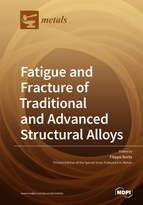Fatigue and Fracture of Traditional and Advanced Structural Alloys
A special issue of Metals (ISSN 2075-4701). This special issue belongs to the section "Metal Failure Analysis".
Deadline for manuscript submissions: closed (30 November 2020) | Viewed by 41978
Special Issue Editor
Interests: fatigue and fracture behavior of materials; mechanical characterization; structural integrity of conventional and innovative materials
Special Issues, Collections and Topics in MDPI journals
Special Issue Information
Dear Colleagues,
Fatigue behavior of traditional and advanced materials is a very relevant topic in different strategic applications impacting and affecting our daily life. The present special issue invites papers to make an update state of the art on this important topic. Both review and original manuscripts are welcome. Special attention will be dedicated to innovative materials and innovative manufacturing processes or post-treatments able to improve the fatigue life and reliability of a structural component. Scale effect will be also fully treated focusing on different applications and multiscale approaches aimed to understand the structural integrity under cyclic loadings. This state of the art will help engineers, designers and people from the academy to have an updated state of the art on this very challenging topic which is nowadays very important due to the advances in manufacturing technologies that allow complex new materials to be fabricated.
Prof. Dr. Filippo Berto
Guest Editor
Manuscript Submission Information
Manuscripts should be submitted online at www.mdpi.com by registering and logging in to this website. Once you are registered, click here to go to the submission form. Manuscripts can be submitted until the deadline. All submissions that pass pre-check are peer-reviewed. Accepted papers will be published continuously in the journal (as soon as accepted) and will be listed together on the special issue website. Research articles, review articles as well as short communications are invited. For planned papers, a title and short abstract (about 100 words) can be sent to the Editorial Office for announcement on this website.
Submitted manuscripts should not have been published previously, nor be under consideration for publication elsewhere (except conference proceedings papers). All manuscripts are thoroughly refereed through a single-blind peer-review process. A guide for authors and other relevant information for submission of manuscripts is available on the Instructions for Authors page. Metals is an international peer-reviewed open access monthly journal published by MDPI.
Please visit the Instructions for Authors page before submitting a manuscript. The Article Processing Charge (APC) for publication in this open access journal is 2600 CHF (Swiss Francs). Submitted papers should be well formatted and use good English. Authors may use MDPI's English editing service prior to publication or during author revisions.
Keywords
- fatigue
- advanced materials
- innovative manufacturing
- scale effects
- aerospace applications






